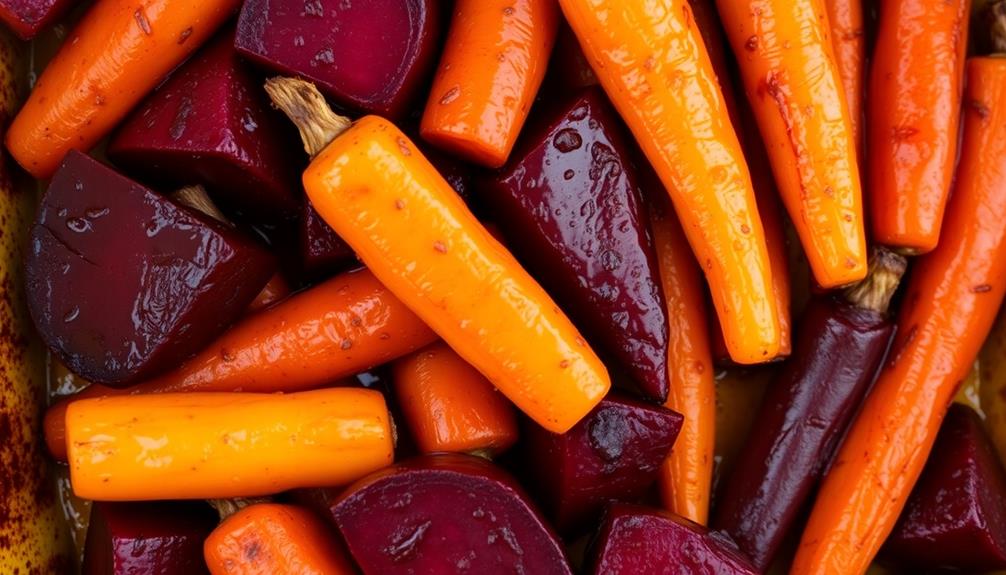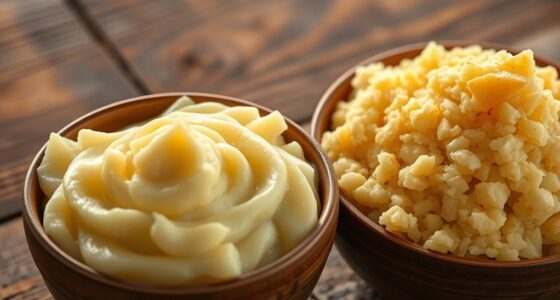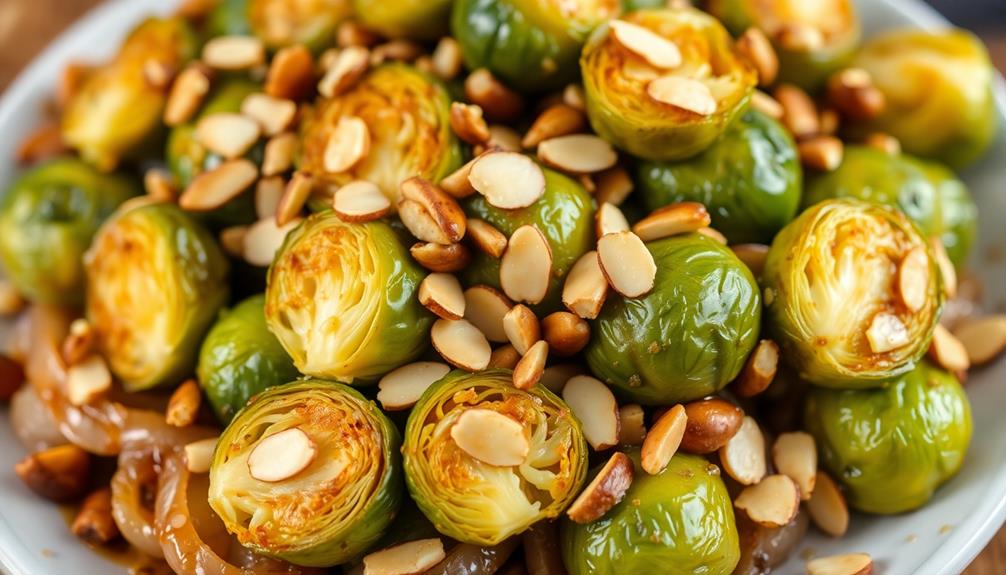Unlock the secret to rich, flavorful root veggies with the classic technique of butter-roasting. For centuries, this simple yet elegant method has drawn out the natural sweetness and earthy flavors of root vegetables. Coat the peeled, cut pieces in melted butter, then roast at high heat until caramelized and tender. A sprinkle of salt and pepper enhances the natural goodness. The result? A comforting, nutrient-dense dish that pairs beautifully with hearty mains. Treat your senses to the sizzling aroma and vibrant colors – it's a weeknight wonder that'll impress even your fanciest dinner guests. Want to learn more about this age-old culinary tradition?
Key Takeaways
- Butter-roasted root vegetables have deep roots in culinary tradition, dating back to early human civilizations and enhancing natural sweetness and earthy flavors.
- The recipe essentials include using 2 pounds of mixed root vegetables, 4 tablespoons of unsalted butter, and seasoning with salt, pepper, and optional herbs.
- Roasting the vegetables at 400°F in a single layer on a baking sheet ensures even cooking and caramelization, resulting in tender textures and rich, flavorful vegetables.
- The butter adds a savory, buttery note that complements the natural sweetness of the root vegetables, creating a perfect balance of flavors.
- Butter-roasted root vegetables are versatile, pairing well with a variety of main courses and offering a simple, yet delicious, way to incorporate more vegetables into one's diet.
History

Rooting deep in culinary tradition, butter-roasted root vegetables have long been a staple in many households. This humble, yet delectable cooking method can be traced back to the earliest days of human civilization, when our ancestors discovered the magic of fire and its transformative powers.
As early societies began to cultivate crops, the simple act of roasting root vegetables in the embers of a fire became a beloved way to extract their natural sweetness and rich, earthy flavors.
Over time, the addition of butter or other fats, herbs, and seasonings further enhanced the taste, creating a dish that wasn't just nourishing, but truly comforting and delicious.
Today, this time-honored technique remains a beloved way to prepare root vegetables, from carrots and potatoes to parsnips and beets.
Whether as a side dish or the centerpiece of a meal, butter-roasted root veggies continue to delight palates and warm hearts, reminding us of the timeless pleasures of simple, wholesome cooking.
Recipe

Roasting root vegetables in butter is a simple and delicious way to bring out their natural sweetness. The combination of crispy edges and tender centers makes for a satisfying and comforting side dish. This recipe is versatile, allowing you to use a variety of root vegetables, making it a great option for the fall and winter seasons. Not only does butter enhance the flavor and moisture of the vegetables, but it also contributes essential vitamins butter is a source of vitamins that are beneficial for your health.
Selecting a mix of different root vegetables, such as carrots, parsnips, potatoes, and beets, will create a visually appealing and flavorful dish. The butter not only adds richness but also helps the vegetables develop a beautiful caramelized crust during the roasting process.
- 2 pounds mixed root vegetables, peeled and cut into 1-inch pieces
- 4 tablespoons unsalted butter, melted
- 2 teaspoons salt
- 1 teaspoon black pepper
- 1 teaspoon dried thyme (optional)
Preheat the oven to 400°F (200°C). Toss the prepared root vegetables with the melted butter, salt, pepper, and thyme (if using) in a large bowl until well coated. Spread the vegetables in a single layer on a large baking sheet. Roast for 30-40 minutes, stirring halfway, until the vegetables are tender and golden brown.
To ensure the best results, it's important to cut the vegetables into uniform pieces to ensure even cooking. For a crispier texture, you can toss the vegetables with the butter and seasonings, then let them sit for 10-15 minutes before roasting to allow the butter to solidify slightly. This will help the vegetables develop a crunchier exterior.
Serve the butter-roasted root vegetables hot, garnished with freshly chopped parsley or thyme, if desired.
Cooking Steps
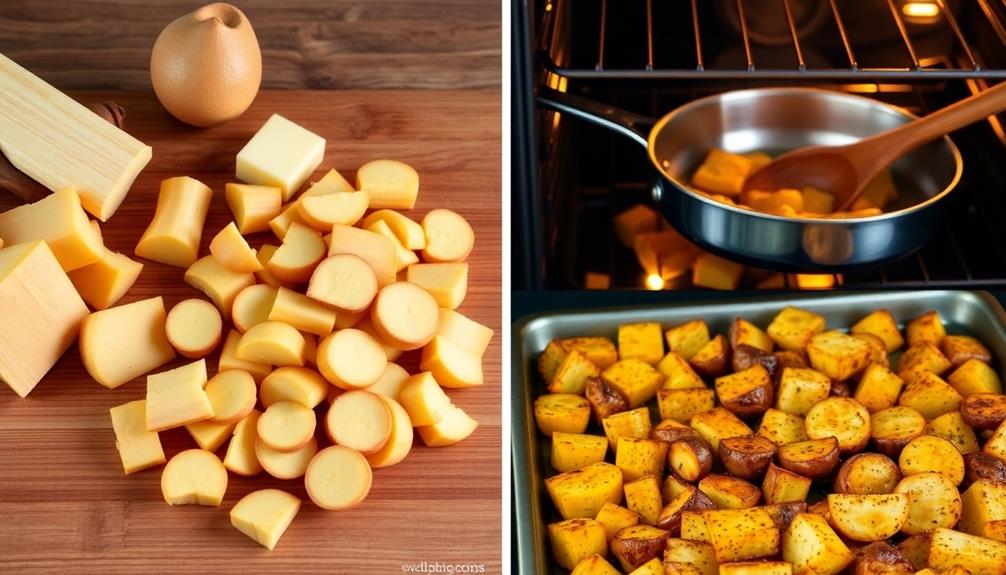
Preheat your oven to 400°F and get ready to work some magic!
Toss those veggies in the melted butter until they're evenly coated, then pop them in the oven to roast until they're tender and delicious.
Don't forget to season with a sprinkle of salt and pepper – the perfect finishing touch before serving up those mouthwatering roasted veggies.
Step 1. Preheat Oven to 400°F
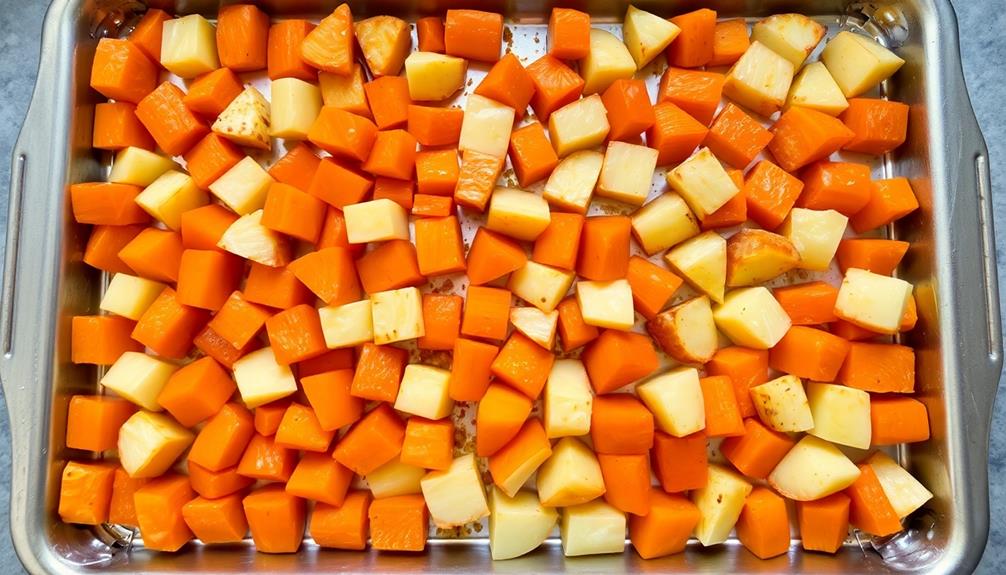
To begin, preheat your oven to 400°F. This important first step is crucial for ensuring your root vegetables cook evenly and develop that delightful, golden-brown caramelization. The high heat will help draw out the natural sugars in the veggies, resulting in a rich, intense flavor.
Once your oven is preheated, you'll want to make sure you have the right baking sheet or roasting pan ready to go. Line it with parchment paper or a silicone mat for easy cleanup. This will create a nonstick surface and prevent the vegetables from sticking as they roast to perfection.
Now, take a moment to admire your freshly preheated oven, its warm glow signaling that it's time to get cooking!
With the oven temperature set, you're one step closer to enjoying those heavenly butter-roasted root vegetables. Get ready to fill your kitchen with mouthwatering aromas as you prepare to embark on this flavorful culinary journey.
Step 2. Toss Veggies With Melted Butter
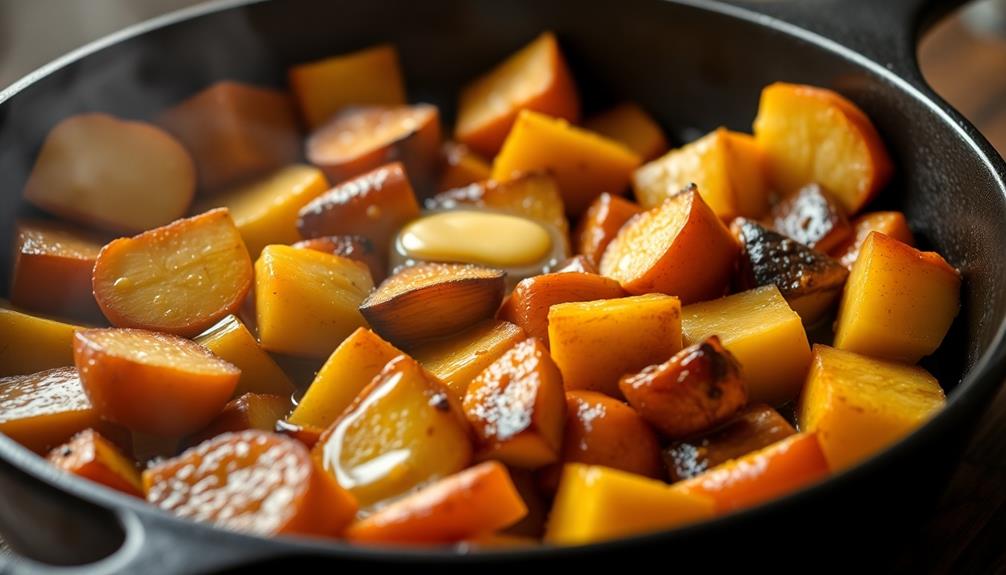
In a large bowl, toss the prepared root vegetables with the melted butter. The warmth of the butter will help the vegetables absorb all the rich, savory flavors as you gently mix everything together.
You'll want to make sure each piece is evenly coated, so use your hands or a large spoon to thoroughly combine the butter and veggies. The butter will add a lovely shine and glaze to the vegetables, enhancing their natural sweetness.
Take your time with this step, really working the butter into every nook and cranny. You want to ensure maximum flavor in each bite.
Once the vegetables are evenly coated, you're ready to transfer them to the prepared baking sheet and pop them in the oven. Get ready for your kitchen to be filled with the mouthwatering aroma of butter-roasted goodness!
Step 3. Roast Vegetables Until Tender
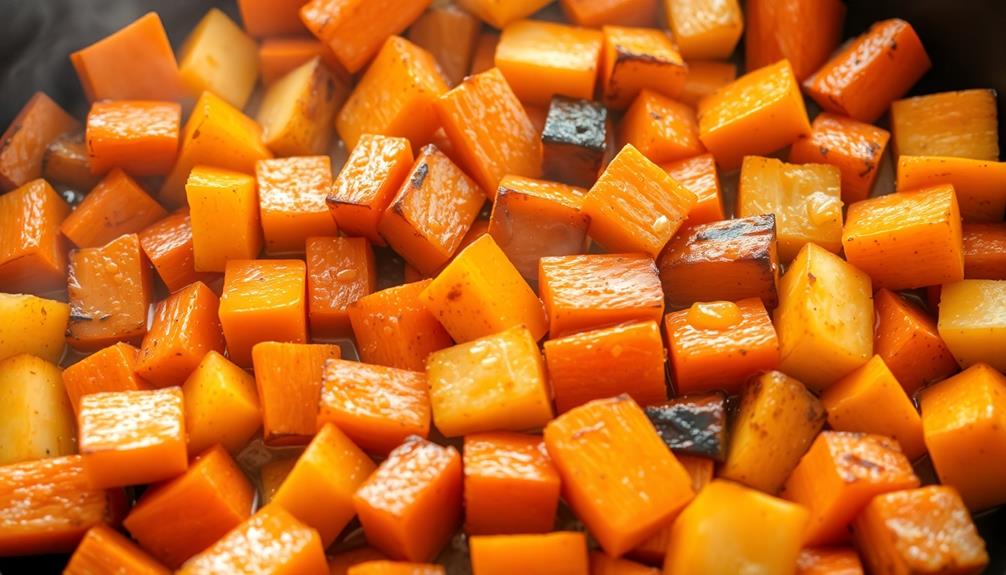
Once the vegetables are evenly coated in the melted butter, you'll want to arrange them in a single layer on the prepared baking sheet. This ensures they roast evenly, developing a delightful caramelized exterior and tender, flavorful interior.
Preheat your oven to a toasty 400°F, and slide the tray into the hot oven. As the vegetables roast, the butter will sizzle and brown, infusing them with a rich, nutty aroma. To maintain a pleasant cooking environment, consider using an air purifier for cleaner air in your kitchen, especially if you're sensitive to cooking odors.
Resist the urge to peek too often, as opening the oven door can disrupt the heat and slow the roasting process. After about 25-30 minutes, you'll start to see the edges of the vegetables turn golden brown. Use a spatula to gently flip and rotate the pieces, then return the tray to the oven.
Continue roasting until the vegetables are fork-tender, which should take another 15-20 minutes. The result? Perfectly roasted root veggies bursting with buttery, caramelized flavor in every bite.
Step 4. Season With Salt and Pepper
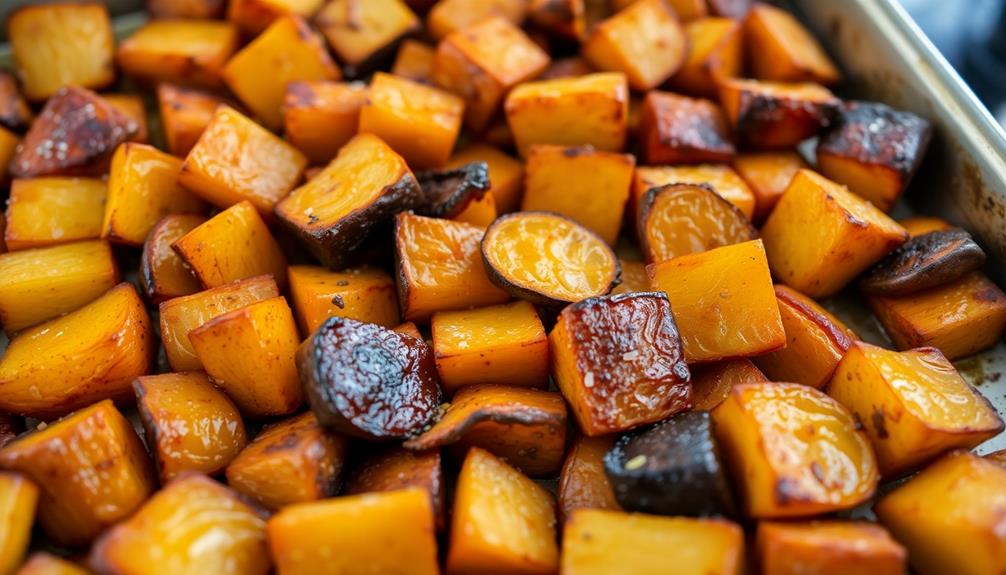
With the vegetables now perfectly roasted, it's time to bring out their full flavor potential. Grab a pinch of salt and sprinkle it generously over the golden-brown veggies. The salt will enhance the natural sweetness of the carrots, parsnips, and potatoes, making each bite more delightful.
Don't be shy – go ahead and grind some fresh black pepper over the top as well. The peppery kick will provide a nice contrast to the buttery richness.
As you season, imagine the flavors mingling together, creating a mouthwatering aroma that fills the kitchen. Take a moment to inhale deeply, allowing the scents to awaken your senses.
Now, use a sturdy spatula to gently toss the vegetables, ensuring the salt and pepper are evenly distributed. You'll notice the spices cling to the caramelized edges, locking in that incredible flavor.
With just a few simple seasonings, your roasted root vegetables are now ready to delight your taste buds.
Step 5. Serve Roasted Veggies Immediately
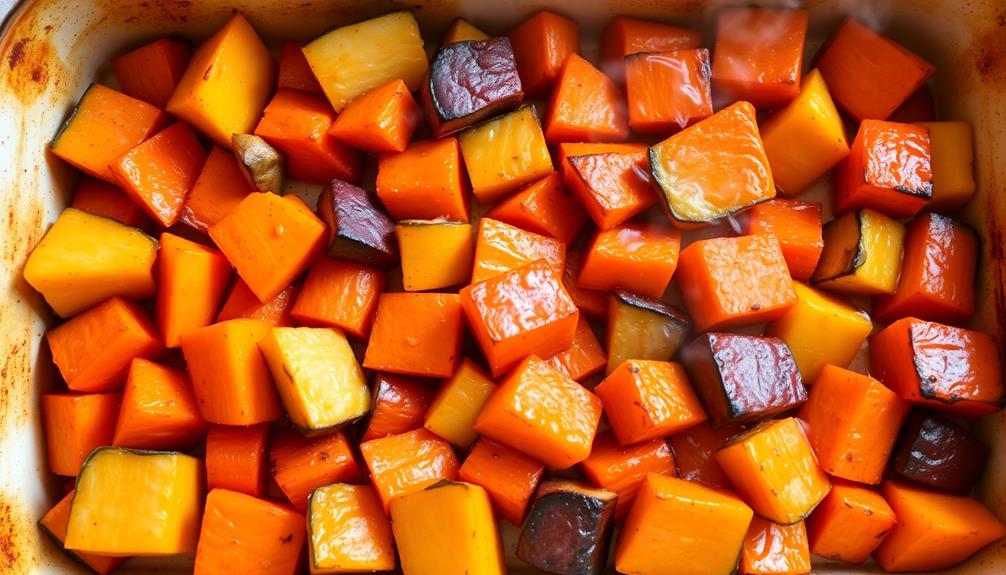
Serve the roasted vegetables immediately while they're hot and at their peak flavor. This is the best time to enjoy their rich, caramelized sweetness and tender textures.
Don't wait – transfer the roasted veggies from the baking sheet to a serving dish right away. The high heat has cooked them to perfection, and you don't want to lose that precious crispness on the edges.
Arrange the vegetables in an attractive way on the plate, letting their vibrant colors shine. The golden-brown carrots, deep purple beets, and earthy potatoes make for a visually stunning presentation.
Sprinkle a bit of fresh parsley or thyme over the top for a pop of green. Serve immediately while the butter is still sizzling and the aromas fill the air.
This is the moment your family and friends have been waiting for! Grab your forks and dig in to savor every delicious bite of these butter-roasted root vegetables.
Final Thoughts

Ultimately, you'll find that these butter-roasted root vegetables make for a delightful side dish, complementing a wide range of main courses. The rich, caramelized flavors and tender textures are sure to delight your taste buds. Plus, the preparation is surprisingly simple, making it an easy addition to your weeknight dinner rotation. Using salted butter can enhance the taste even further, adding depth to each bite.
Whether you're serving these veggies alongside a juicy steak, roasted chicken, or a hearty vegetarian entree, they'll provide a delicious contrast and balance. The natural sweetness of the root vegetables shines through, perfectly offset by the savory, buttery notes.
And the vibrant colors – golden-brown carrots, deep purple beets, and earthy parsnips – make for an eye-catching presentation that's sure to impress your guests.
With just a few basic ingredients and minimal hands-on time, you can elevate your meal with these flavorful, nutrient-dense roasted root vegetables. Give them a try, and prepare to be amazed by the depth of flavor they bring to the table.
Frequently Asked Questions
What Is the Best Way to Clean and Prepare the Vegetables?
To clean and prepare the vegetables, start by thoroughly washing them under running water. Peel any tough skins, then chop or slice the veggies into even-sized pieces for even cooking. Dry them completely before roasting for the best results.
Can This Recipe Be Made in Advance and Reheated?
Yes, you can make this recipe in advance and reheat it. The roasted vegetables will keep well in the refrigerator for up to 4 days, and they'll reheat beautifully in the oven or microwave when you're ready to serve them.
How Can I Ensure the Vegetables Are Evenly Cooked?
To ensure even cooking, cut the vegetables into uniform pieces. Spread them in a single layer on a baking sheet, and rotate the pan halfway through the roasting time. This will help the vegetables cook evenly.
Can I Substitute Different Types of Root Vegetables?
Absolutely! You can substitute different types of root vegetables in this recipe. Carrots, parsnips, turnips, and potatoes all work well. Just make sure to adjust the cooking time as needed based on the size and density of your chosen veggies.
How Can I Add More Flavor to the Dish?
To add more flavor to your dish, try incorporating aromatic herbs and spices like rosemary, thyme, garlic, or cumin. You could also toss the roasted veggies in a light glaze or sauce to boost the flavor profile.
